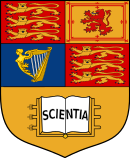
Back كلية لندن الإمبراطورية Arabic امبيريال كوليدج لندن ARZ Imperial College London AST London İmperial Kolleci Azerbaijani لندن ایمپیراتورلوغ کالجی AZB Imperial College London BAN ইম্পেরিয়াল কলেজ লন্ডন Bengali/Bangla Imperial College London Catalan Imperial College London Czech Coleg Imperial Llundain Welsh
 | |||||||||||||||||||||||
| Motto | Scientia, imperii decus et tutamen (Latin) | ||||||||||||||||||||||
|---|---|---|---|---|---|---|---|---|---|---|---|---|---|---|---|---|---|---|---|---|---|---|---|
Motto in English | "Scientific knowledge, the crowning glory and the safeguard of the empire" | ||||||||||||||||||||||
| Type | Public research university | ||||||||||||||||||||||
| Established | 8 July 1907[1] | ||||||||||||||||||||||
| Endowment | £220.1 million (2022/23)[2] | ||||||||||||||||||||||
| Budget | £1.256 billion (2022/23)[2] | ||||||||||||||||||||||
| President | Hugh Brady | ||||||||||||||||||||||
| Provost | Ian Walmsley | ||||||||||||||||||||||
Academic staff | 4,440 (2020/21)[3] | ||||||||||||||||||||||
Administrative staff | 4,115 (2020/21)[3] | ||||||||||||||||||||||
| Students | 22,791 (2020/21)[4] | ||||||||||||||||||||||
| Undergraduates | 11,722 (2020/21)[4] | ||||||||||||||||||||||
| Postgraduates | 11,069 (2020/21)[4] | ||||||||||||||||||||||
| Location | London , England 51°29′54″N 0°10′37″W / 51.49833°N 0.17694°W | ||||||||||||||||||||||
| Scarf | |||||||||||||||||||||||
| Colours | Blue[5] | ||||||||||||||||||||||
| Affiliations | |||||||||||||||||||||||
| Mascot | Lion | ||||||||||||||||||||||
| Website | imperial | ||||||||||||||||||||||
Imperial College London (Imperial) is a public research university in London, England. Its history began with Prince Albert, husband of Queen Victoria, who envisioned a cultural area including the Victoria and Albert Museum, the Royal Albert Hall, the Natural History Museum and several royal colleges.[6][7] Established in 1907 by royal charter, Imperial College London merged the Royal College of Science, the Royal School of Mines, and the City and Guilds of London Institute to form a university college.[8] In 1988, the Imperial College School of Medicine was formed through a merger with St Mary's Hospital Medical School. In 2004, Queen Elizabeth II opened the Imperial College Business School.
The university focuses on science, engineering, business, and medicine, where it has an entrepreneurial culture.[9] The main campus is in South Kensington, and a second campus in White City serves as a hub for innovation, entrepreneurship, and research.[10] The faculty of medicine also operates five teaching hospitals across London. The university was previously a constituent college of the University of London and became an independent university in 2007.[11] With over 60% international students, Imperial represents around 140 countries on campus.[12][13]
- ^ "Charitable status". Imperial College London. Archived from the original on 4 June 2020. Retrieved 4 June 2020.
- ^ a b "Annual Report and Accounts 2022–23". Imperial College London. 30 November 2023. Retrieved 8 December 2023.
- ^ a b "Who's working in HE?". hesa.ac.uk. Archived from the original on 29 July 2019. Retrieved 26 July 2024.
- ^ a b c "Statistics Guide 2020–21" (PDF). Archived (PDF) from the original on 18 January 2024. Retrieved 26 July 2024.
- ^ "Imperial Brand Project". Imperial College London. Archived from the original on 27 February 2024. Retrieved 27 February 2024.
- ^ "Prince Albert's cultural vision and the history of South Kensington: What is Albertopolis?". Royal Albert Hall. Archived from the original on 12 January 2019. Retrieved 3 January 2019.
- ^ "Chemistry at Imperial". Imperial College London. Retrieved 24 December 2018.
- ^ "City and Guilds College ─ Imperial College". architecture.com. Royal Institute of British Architects. Archived from the original on 2 October 2012.
- ^ Hall, Rachel (24 September 2022). "Imperial College London: inside the university that is in the business of studying". The Guardian. ISSN 0261-3077. Archived from the original on 26 July 2024. Retrieved 16 March 2024.
- ^ "White City Campus". Imperial College London. 19 March 2024. Retrieved 14 March 2024.
- ^ Cite error: The named reference
GuardSplitwas invoked but never defined (see the help page). - ^ "Student Nationality | Administration and support services | Imperial College London". imperial.ac.uk. Archived from the original on 19 March 2024. Retrieved 19 March 2024.
- ^ "Most international universities in the world 2018: top 200". Times Higher Education. 14 March 2018. Archived from the original on 21 March 2021. Retrieved 26 July 2024.
© MMXXIII Rich X Search. We shall prevail. All rights reserved. Rich X Search